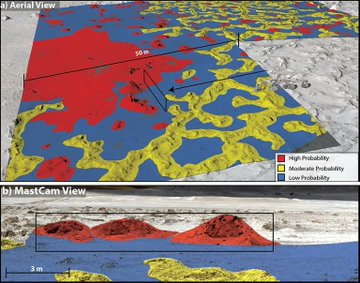
An artificial-intelligence model trialled in Chile’s Atacama Desert could one day detect signs of life on other planets.
Artificial intelligence (AI) and machine learning could revolutionize the search for life on other planets. But before these tools can tackle distant locales such as Mars, they need to be tested here on Earth.
A team of researchers have successfully trained an AI to map biosignatures — any feature which provides evidence of past or present life — in a three-square-kilometre area of Chile’s Atacama Desert. The AI substantially reduced the area the team needed to search and boosted the likelihood of finding living organisms in one of the driest places on the planet. The results were reported on 6 March in Nature Astronomy1.
Kimberley Warren-Rhodes, a senior research scientist at the SETI Institute in Mountain View, California, and lead author on the paper, has been chasing biosignatures since the early 2000s, when she realized how few tools existed to study the biology of other planets. She wanted to combine her background in statistical ecology with emerging technologies such as AI to help mission scientists, “who are under a lot of pressure to find biosignatures” but tightly constrained in how they do so. Rovers that are controlled remotely from Earth, for example, can travel only limited distances and collect relatively few specimens, placing a premium on sampling locations that are the most likely to yield life. Mission scientists base these predictions in part on Mars analogues on Earth, where scientists scour extreme habitats to determine how and where living organisms thrive.
Searching for life
Beginning in 2016, Warren-Rhodes’ group travelled to the high, parched plateau of the Atacama Desert — a proposed Mars analogue at an elevation of around 3,500 metres in the Chilean Andes — to search for rock-dwelling, photosynthetic organisms called endoliths. To fully characterize the environment, the researchers collected everything from drone footage to geochemical analyses to DNA sequences. Together, this data set mimics the types of information researchers are collecting on Mars with orbital satellites, drones and rovers.
Warren-Rhodes’ team fed its data into an AI-based convolutional neural network (CNN) and a machine-learning algorithm that in turn predicted where life was most likely to be found in the Atacama.
